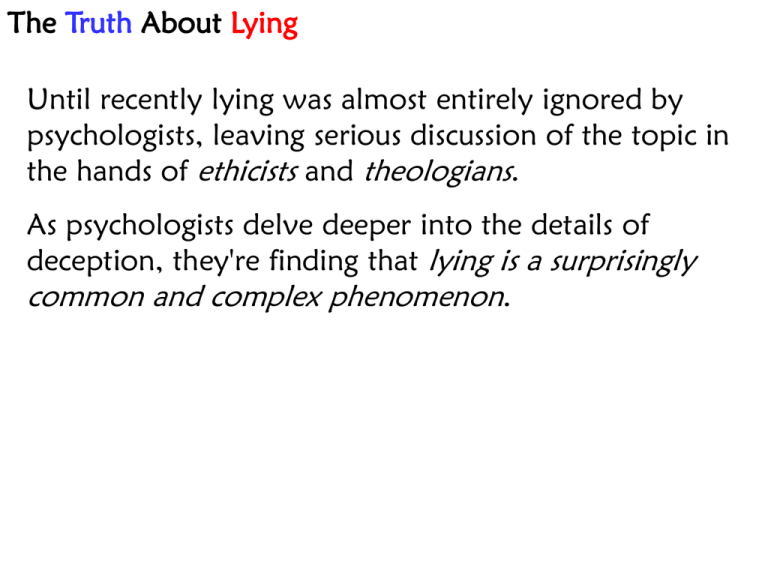Truth About Lying
advertisement

The Truth About Lying Until recently lying was almost entirely ignored by psychologists, leaving serious discussion of the topic in the hands of ethicists and theologians. As psychologists delve deeper into the details of deception, they're finding that lying is a surprisingly common and complex phenomenon. The Truth About Lying In a 1996 study, Bella DePaulo, Ph.D., a psychologist at the University of Virginia, and her colleagues had 147 people between the ages of 18 and 71 keep a diary of all the falsehoods they told over the course of a week. Most people, she found, lie once or twice a day -almost as often as they snack or brush their teeth. Both men and women lie in approximately 1/5 of their social exchanges lasting 10 or more minutes Over the course of a week they deceive about 30% of those with whom they interact one-one. The Truth About Lying "College students lie to their mothers in one out of two conversations," reports DePaulo. Incidentally, when researchers refer to lying, they don't include the mindless or polite pleasantries we offer each other in passing, such as "I'm fine, thanks" or "No trouble at all." An "official" lie actually misleads, deliberately conveying a false impression. So, complimenting a friend's awful haircut or telling a creditor that the check is in the mail both qualify. The Truth About Lying Although we're socialized from the time we can speak to believe that it's always better to tell the truth, in reality society often encourages and even rewards deception. Show up late for an early morning meeting at work and it's best not to admit that you overslept. "You're punished far more than you would be if you lie and say you were stuck in traffic," Saxe notes. Moreover, lying is integral to many occupations. Think how often we see lawyers constructing farfetched theories on behalf of their clients or reporters misrepresenting themselves in order to gain access to good stories. The Truth About Lying 85% of the couples interviewed in a study of college students reported that one or both partners had lied about past relationships or recent indiscretions. DePaulo finds that dating couples lie to each other in about 1/3 of their interactions perhaps more often than they deceive others Fortunately, marriage seems to offer some protection against deception: Spouses lie to each other in "only" about 10 % of their major conversations. The Truth About Lying "fake positive" lies -those in which people pretend to like someone or something more than they actually do ("Your muffins are the best ever") -are about 10 to 20 times more common than… "false negative" lies -in which people pretend to like someone or something less ("That two-faced rat will never get my vote"). The Truth About Lying Certain cultures may place special importance on these "kind" lies. A survey of residents at 31 senior citizen centers in Los Angeles recently revealed that only about 50% of elderly Korean Americans believe that patients diagnosed with life-threatening metastatic cancer should be told the truth about their condition. In contrast, nearly 90% of Americans of European or African descent felt that the terminally ill should be confronted with the truth. The Truth About Lying Although the M/F lie with equal frequency… Women are especially likely to stretch the truth in order to protect someone else's feelings<DePaulo> Men, on the other hand, are more prone to lying about themselves -the typical conversation between two guys contains about eight times as many self-oriented lies as it does falsehoods about other people The Truth About Lying In a University of Virginia study, psychologists asked pairs of same-sex friends to try to detect lies told by the other person. Six months later the researchers repeated the experiment with the same participants. Over time, Women had become slightly better at detecting their friend's lies Men didn't show any improvement. The Truth About Lying In a study published in the Journal of Personality and Social Psychology, DePaulo and Deborah A. Kashy, Ph.D., of Texas A&M University, report that frequent liars tend to be manipulative, not to mention overly concerned with the impression they make on others. Still, DePaulo warns that liars “don't always fit the stereotype of caring only about themselves.” Further research reveals that extroverted, sociable people are slightly more likely to lie. Some personality and physical traits - notably selfconfidence and physical attractiveness - have been linked to an individual's skill at lying when under pressure. The Truth About Lying Researchers such as UCLA psychologist Shelley Taylor, Ph.D., have cited such findings as evidence that a certain amount of self-delusion--basically, lying to yourself--is essential to good mental health. The Truth About Lying Few experts display much confidence in the deception-detecting abilities of the polygraph, or lie detector. Geoffrey C. Bunn, Ph.D., a psychologist and polygraph historian at Canada's York University, goes so far as to describe the lie detector as “an entertainment device” rather than a scientific instrument. Problem with the polygraph: it detects fear, not lying The physiological responses it measures - most often heart rate, skin conductivity, and rate of respiration - don't necessarily accompany dishonesty. “The premise of a lie detector is that a smoke alarm goes off in the brain when we lie because we're doing something wrong,” explains Saxe. “But sometimes we're completely comfortable with our lies.” the bestcontrolled research suggests that lie detectors err at a rate anywhere from 25 to 75 percent. Perhaps this is why most state and federal courts won't allow polygraph “evidence.” The Truth About Lying Some studies suggest that lies can be detected by means other than a polygraph e.g. speech hesitations or changes in vocal pitch scratching, blinking, or fidgeting. But most psychologists agree that lie detection is destined to be imperfect. Researchers continue to investigate new ways of picking up lies. The Truth About Lying James W. Pennebaker, Ph.D., a professor of psychology at Southern Methodist University, began to explore whether a person's choice of words was a sign of deception. Examining data gathered from a text analysis program, Pennebaker and SMU colleague Diane Berry, Ph.D., determined that there are certain language patterns that predict when someone is being less than honest. For example, liars tend to use fewer first person words like I or my in both speech and writing. They are also less apt to use emotional words, such as hurt or angry, cognitive words, like understand or realize, and so-called exclusive words, such as but or without, that distinguish between what is and isn't in a category. The Truth About Lying DePaulo's studies, participants described conversations in which they lied as less intimate and pleasant than truthful encounters, suggesting that people are not entirely at ease with their deceptions. That may explain why falsehoods are more likely to be told over the telephone, which provides more anonymity than a face-to-face conversation. In most cases, however, any mental distress that results from telling an everyday lie quickly dissipates. The Truth About Lying Those who took part in the diary study said they would tell about 75% of their lies again if given a second chance —a position likely bolstered by their generally high success rate. Only about 1/5 of their falsehoods were discovered during the one-week study period. The Truth About Lying It's tempting to think that the world would become a better place when purged of the deceptions that seem to interfere with our attempts at genuine communication or intimacy. On the other hand, perhaps our social lives would collapse under the weight of relentless honesty, with unveiled truths destroying our ability to connect with others. But then, I could be lying. The Truth About Lying Eyes When asked a question, a ‘typical’ right-handed person looks… (from your viewpoint, looking at them) The Truth About Lying Up and to the Left Visually Constructed Images (Vc) If you asked someone to "Imagine a purple snake," this would be the direction their eyes moved while thinking about the question as they "Visually Constructed" a purple snake in their mind. Eyes Up and to the Right Visually Remembered Images (Vr) If you asked someone "What color was the first house you lived in?," this would be the direction their eyes moved while thinking about the question as they "Visually Remembered" the color of their childhood home. The Truth About Lying To the Left Auditory Constructed (Ac) If you asked someone to "Try to create the sound of supernova in your head," this would be the direction their eyes moved while thinking about the question as they "Auditorily Constructed" this sound that they have never heard. Eyes To the Right Auditory Remembered (Ar) If you asked someone to "Remember what their favorite song sounds like,“ this would be the direction their eyes moved while thinking about the question as they "Auditorily Remembered " this sound. The Truth About Lying Down and to the Left Feeling / Kinesthetic (F) If you asked someone to "Can you remember the smell of a campfire? " This would be the direction their eyes moved while thinking about the question as they used Feeling / Kinesthetic to recall a smell, feeling or taste. Eyes Down and To the Right Internal Dialog (Ai) This is the direction of someone eyes as they "talk to themselves." The Truth About Lying Eyes The Truth About Lying Eyes How this information may be used to detect lies: Example: Let's say the child you’re babysitting asks you for a cookie, and you ask them "well, what did your mother say?" As they reply "Mom said... yes." they look to the left. This would indicate a made up answer as their eyes are showing a "constructed image or sound. Looking to the right would indicated a "remembered" voice or image, and thus would be telling the truth. The Truth About Lying Eyes Other notes: Looking straight ahead or with eyes that are defocused/unmoving is also considered a sign of visual accessing. A typical left-handed person would have the opposite meanings for their eye-directions. As with other signs of lying, you should first establish and understand a persons base-behavior before concluding they are lying by the direction of their eyes. Remember…this is not always accurate The Truth About Lying Detection Body Language: •Physical expression limited/stiff •Few arm/hand movements •Hand, arm/leg movement toward their own body •Liars takes up less space •Avoid eye contact •Hands touching their face, throat & mouth •Touches or scratches the nose or behind their ear The Truth About Lying Detection Emotional Gestures & Contradiction •Timing/duration of emotional gestures/emotions off normal pace. •Display of emotion delayed, stays longer it would naturally, then stops suddenly. •Timing off between emotions gestures/expressions and words. •e.g. Someone says "I love it!" when receiving a gift, and then smile after making that statement, rather then at the same time the statement is made. •Gestures/expressions don’t match the verbal statement, •e.g. frowning when saying “I love you.” •Expressions are limited to mouth movements when someone is faking emotions (like happy, surprised, sad, awe, )instead of the whole face. •e.g. when someone smiles naturally their whole face is involved: jaw/cheek movement, eyes, forehead push down, etc. The Truth About Lying Detection Interactions and Reactions •Guilty = defensive. •Innocent = offensive. •GO AWAY! •Liar uncomfortable facing his questioner/accuser and may turn his head or body away. •THE WALL: •Liar might unconsciously place objects (book, coffee cup, etc.) between themselves and you. The Truth About Lying Detection Verbal Context and Content •Liars will use your words to answer a question. •e.g. when asked, “Did you eat the last cookie?” The liar answers, “No, I did not eat the last cookie.” •A statement with a contraction is more likely to be truthful: “I didn't do it” instead of “I did not do it” •Liars sometimes avoid "lying" by not making direct statements. •They imply answers instead of denying something directly. •Guilty person may speak more than natural, adding unnecessary details to convince you...not comfortable with silence or pauses in the conversation. The Truth About Lying Detection Verbal Context and Content •Liars may leave out pronouns and speak in a monotonous tone. •When a truthful statement is made the pronoun is emphasized as much or more than the rest of the words in a statement. •Words may be garbled, mumbled, spoken softly •i.e. sentences will likely be muddled rather than emphasized. The Truth About Lying In the end, we’re left with our instincts, intuition, gut feelings, perceptions, biases, backgrounds, needs, desires, knowledge, interests, empathy, sympathy, trust, compassion and faith in others to determine the truth – reflected in those we encounter, and within the mirrors on the wall. Best wishes… Various sources used and noted, while some content/statistics courtesy Psychology Today





